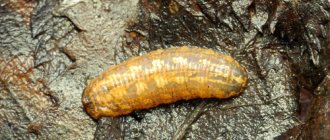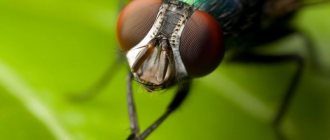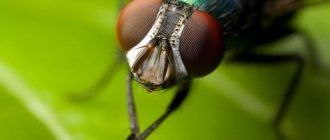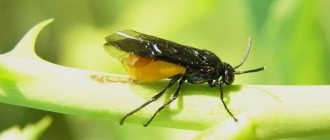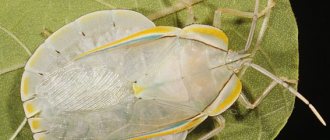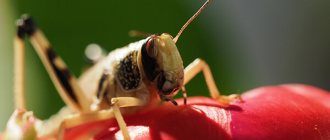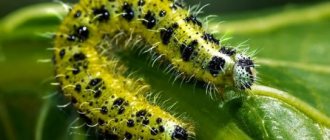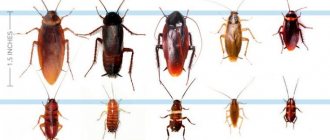Botanical description
The moth or surveyor is part of the Butterfly family, which has a huge number of species.
The butterfly is called a moth for the similarity of the way its caterpillar moves with a span, that is, a hand. The scientific name Geometridae is translated from Greek as “land surveyor,” which is also associated with the peculiarity of movement.
The moth, as seen in the photo, looks like a small or medium-sized butterfly with an elongated thin body and two pairs of wings - the upper ones in the shape of a triangle and the lower ones rounded. The wingspan of the moth depends on the type of butterfly and varies from 9–50 mm (usually 30). In females, the lower wings reach the end of the abdomen, while in the male they protrude slightly beyond it.
The coloring of the wings of most moths is protective, which gives them the opportunity to remain unnoticed on tree trunks and branches.
At rest, the moth folds its wings parallel to its body. Some butterflies lift them up and press them against each other. Both positions make them look like a folded piece of paper, which makes for good camouflage.
The moth has no eyes; the antennae of males are thread-like, while those of females are feathery or comb-like. The spiral proboscis is not well developed, the limbs are thin.
Caterpillars have a thin, long body with two underdeveloped pairs of legs, which are located in the middle part of the abdomen.
This structure determines the characteristic way of movement of the caterpillar - resting on the thoracic legs, it bends and lifts the middle part of the body and tightens the hind limbs. Then, resting his hind limbs, he stretches out the front part of the body.
Interesting! The presence of well-developed muscles allows the caterpillar to take a vertical position, standing on its hind legs.
Diagnostic signs
Butterfly
– white with large black spots of irregular shape, wingspan 40-50 mm (45-62 mm). The wings are white, covered with numerous dark brown stripes; almost black specimens are found in industrial areas (industrial melanism). The fore wings are narrow, elongated towards the apex, with two, and the hind wings with a serrated stripe.
Caterpillars
– 45-55 mm long, large, brown, yellowish-green or gray, imitating the color of the substrate on which it is located; with a dark stripe on the back and large white warts on the 5th and 8th abdominal segments. The color varies greatly from brown to yellow-green, usually combined with the color of birch branches. The head protrudes vertically forward, obliquely in front, rope-like, with a deep notch, so that the hemispheres have sharp tubercles (as if horned). Spiracles rusty red August September
Doll
– brown-red (dark brown), 17-20 mm long. The first pair of spiracles is located on large aspiral tubercles, and the pupa has ears.
Lifestyle
The moth's weak wings do not allow it to make long flights, so this butterfly moves short distances and mainly in the dark. Some species fly during the day, but only in dry, windless weather.
Interesting! The females of some species of moths do not fly at all, which greatly facilitates the fight against them.
Throughout its short life, the butterfly feeds on flower nectar or does not eat at all (this depends on the species).
After mating, the moth lays elongated oval eggs on the bark or vegetative parts of fruit and ornamental plants. The larvae hatching from the eggs begin to actively devour green buds and leaves, and by the time of pupation they descend to the ground. This pest overwinters in a pupa, from which a butterfly emerges in the spring, after which the process is repeated again.
Habitats
The birch moth is a very numerous species. Its representatives can be found almost throughout Europe. The only exception is the Far North, since the climate prevailing there is completely unsuitable for her way of life. The same rule applies to Russian lands.
It should be understood that trees are extremely important for the survival of this insect. Therefore, it tries to settle in those areas where there is excellent access to them. The ideal environment is fruit plantations or forests. However, if there are none, then the birch moth can easily make do with a city park or public garden.
Types of moths
Among the variety of moths, not all are harmful. Several moth pests can be found in the Russian Federation.
Sosnovaya
Gray wings with a red tint, decorated with zigzags and small spots of white, black, and brown, make this moth inconspicuous against the background of tree bark. During the development period, caterpillars actively devour needles, which causes significant damage to coniferous forests, especially young plantings.
Berezovaya
Black spots on the wings allow this butterfly to remain unnoticed, blending in with the trunks of birch trees. Young caterpillars feed not only on birch leaves. They also like hazel and alder.
Black
The wings of this butterfly are black with a thin white edge along the upper edge. The caterpillar's body is green and velvety. Basically, these pests eat the leaves of chestnut trees, but they do not refuse other green spaces.
Fir
Thanks to its grayish wings with wavy lines, the fir moth on plants can be mistaken for a piece of a dry branch. This pest feeds on fir needles, but on occasion it can also devour other bushes and trees.
Gooseberry
A multi-colored butterfly whose white wings are decorated with alternating black and yellow stripes. The caterpillar of this moth also has a beautiful coloration.
The gooseberry moth causes trouble to gardeners more than its other relatives. The fact is that the caterpillar’s list of victims includes not only gooseberry bushes, but also stone fruit trees.
Winter
An inconspicuous butterfly with black lines on grayish wings, called the winter moth, is no less dangerous for fruit and ornamental crops than the gooseberry moth. It causes great damage to all garden plants, eating away buds and young seeds from the inside.
Ripped off
A dark brown, cream or light green butterfly whose caterpillars damage almost all types of deciduous trees, as well as fruit and ornamental shrubs. The result of the activity of the peeler is lacerations on the leaf blades of plants.
Mulberry moth
Mulberry leaves are considered the favorite delicacy of the mulberry butterfly caterpillar. In the absence of such, it will feed on the leaves and buds of stone fruit crops.
Tree Defiler
The caterpillar of the birch moth butterfly is one of the most dangerous pests living on the territory of the Russian Federation. Having hatched from the egg, they begin to eat everything that comes along the way, be it leaves, buds, buds, flowers or fruits. And given their number, it is not difficult to guess that literally in one day they can destroy a good part of the greenery on a tree.
Therefore, gardeners try to treat their trees in advance so that they are not attacked by omnivorous caterpillars. In addition, in this difficult struggle, some species of birds come to the aid of people. After all, if adult butterflies are protected by camouflage color, then their offspring are easier and more nutritious prey.
Harm of the moth
It is not the moth butterfly itself that poses a danger to the garden, but its caterpillar, which actively devours both generative and vegetative parts of the plant and is capable of infecting large areas of green spaces in a short time.
The result of the caterpillars' activity is:
- deterioration in fruit quality;
- decrease in yield;
- decreased resistance to cold and disease;
- deterioration of ornamental plants.
To save your garden from this pest, you need to know how to get rid of butterflies and moth caterpillars.
Prevention
Pre-screening methods include:
- periodic treatment with medicinal solutions.
- digging up the soil in the place where crops or trees grow;
- timely watering and care of crops;
- destruction of fallen leaves at the planting site;
Despite the fact that the moth larva has its importance in the biogeocenosis, it is desirable to minimize its numbers. This is due to the fact that the moth larva in most cases does not occupy the most attractive ecological niche – the parasitic one. They also feed on a variety of birds and animals, but their strength is often not enough to keep the population within acceptable limits.
Ways to fight
There are 4 methods of combating moths - agrotechnical, mechanical, biological and chemical. A competent combination of all four methods helps to permanently cleanse the garden of this pest.
Agrotechnical
The list of agricultural activities includes:
- systematic examination of the vegetative parts of trees and shrubs in order to identify pupae and caterpillars;
- regular loosening of the soil in spring and autumn in the root zone of trees and shrubs. This helps destroy pupae overwintering in the soil;
- removing moss deposits from the stems, as well as dead parts of the bark (the removal sites are treated with a solution of copper sulfate);
- spring and autumn whitewashing of trunks of bushes and trees.
Mechanical
The most labor-intensive method of combating moths, which involves:
- manual collection of pupae, caterpillars, and spider nests in which butterflies gather to winter;
- use of catch belts of different designs.
The chemical method is the treatment of plants with chemicals, and the biological method is the attraction of natural enemies of caterpillars - birds, riders, and tahina flies - into the garden. In order to attract the latter, decorative onions or clover are planted on the site.
The list of sanitary measures also includes the treatment of vegetative parts of plants and soil in the root zone with biological preparations.
Morphology
Imago. Little butterfly. Wingspan 22-25 mm. [2] Like all members of the butterfly family, it has a thin, slender body, wide triangular upper wings, rounded hind wings and a developed proboscis. It feeds on the nectar of flowers. [1]
The main color of the wings is white. The pattern of the forewing is formed by dark gray, sometimes merging transverse stripes, as well as small brown and dark gray spots. The design of the rear fenders is similar to the front ones, but is less noticeable. Along the outer edge of the wings, along a light brown border, there are crescent-shaped and triangular brownish-gray or dark gray spots. [2]
The egg is oval in shape, 0.61-0.69 mm long, 0.4-0.5 mm wide. The color changes as it develops from light yellow-green to ocher and brown-olive. [2]
The larva (caterpillar) reaches 20-25 mm in adulthood. The body is almost cylindrical. The head is evenly rounded on the sides, with brown-black spots. The main body color is whitish-green. The back and lateral lines are whitish-yellow. [2]
Doll. Length – 9.8-10.5 mm. The Cremaster is triangular in shape with two large lyre-curved apical arms and six small curled hooks at the end. [2]
| Phenology of development (in days) | |
| Transformation | Full |
| Full cycle | 1 year |
| Egg (embryo) | 10-15 |
| Larva | 2-3 months |
| Chrysalis | 8-9 months |
Pest control products
In the process of fighting voracious caterpillars, both ready-made store-bought preparations and folk remedies for moths are used.
Biological and chemical preparations
It is easier to prevent an invasion of caterpillars than to get rid of them later. To do this, in the spring (before flowering), trees and bushes are treated with insecticides (Aktellik, Karbofos, Zolon, etc.)
If there is an urgent need to spray plants during flowering or fruiting, for example, if there are too many caterpillars, only biological agents such as Bitoxibacillin, Fitoverm, etc. can be used to treat moths.
Folk remedies
Compared to chemicals, homemade products are less effective, but also less toxic. Therefore, if the situation is not critical, you can use the following to destroy the moth:
Tomato tops. 1 kg of fresh tops is poured with water and left to infuse for 24 hours. Then cook it all over low heat for a couple of hours and filter. The cooled product is used for spraying fruit and ornamental crops.
Spurge. Fresh grass is poured with water so that it covers it completely, and left for 2-3 days. The finished infusion is filtered through cheesecloth and sprayed on the trees.
Hot pepper. 10 pieces. Finely chop the pepper, add water (about 1.5 liters) and cook for 1 hour. The finished broth is left for 2 days, then filtered and used for processing garden crops.
By the same principle, you can use burdock leaves, tansy and wormwood. Treatment with herbal remedies is absolutely safe for human health, so it can be carried out an unlimited number of times.
The moth, if not dealt with, can cause great harm to fruit and ornamental plants. Properly organized plant care, which includes preventive treatment of garden crops and timely destruction of pests if they appear, will help prevent trouble.
Bapta temerata
| Synonyms | Birch moth full-bodied, birch moth full-bodied |
| In English | Bapta seasoned |
| Class | Insects – Insecta |
| Squad | Lepidoptera (butterflies) – Lepidoptera |
| Family | Moths - geometrids |
| Biological group | Pests of stone fruit crops; Pests of pome crops; Pests of fruit crops; forest pests; Pests of ornamental crops; Parasites of urban greenery |
| Special signs | General form |
| Birch moth from all sides is a pest of apple, cherry, and plum trees. In addition, it damages beeches, oaks, willows, birches, maples, roses and thorns by eating leaves. Reproduction is bisexual. The pupa overwinters in a dense compact cocoon in the ground. One generation of the parasite develops per year. |
| Summary data | |
| Fertility (pcs) | 100 |
| Generations per year | 1 |
| Egg(mm) | length 0.61-0.69 mm width 0.4-0.5 mm |
| Larva (mm) | 20-25 |
| Pupa (mm) | 9,8-10,5 |
| Wingspan (mm) | 22-25 |
Pyadenitsa Photos
Insects attacking needles, shoots and roots
This group includes a large number of insects. They feed on bark, roots, needles, young and last year's shoots. If these pests appear in large numbers, they can even cause the death of the plant. Many of this group of pests are beetles.
The most common among them:
- large pine weevil - prefers young trees.
- gray pine weevil - adult beetles (up to 11 mm long) feed on bark and needles, the larvae damage the roots;
- spot resin - small beetles (up to 7 mm) are dangerous for bark and needles, and the larvae gnaw passages in the tree;
Some pine pests are butterflies from the Shootweed family. This group includes summer, resinous, sprouted and wintering shoots. The larvae of these insects, which can be different, are dangerous for trees: in a victorious winter it is a black caterpillar, in others it is brown, gray, orange.
Pine pests are insects that, during their lifetime, damage the bark, shoots, needles or roots of trees. They can belong to different groups, but very often the larval stages are harmful. The fight against caterpillars should be annual. It is enough to use insecticides according to the instructions, and pests will not appear on the site.
Industrial melanism [ edit | edit code]
It is the most famous example of industrial melanism. Until the middle of the 19th century, all specimens of the birch moth collected by entomologists had white-grayish wings with dark spots ( morpha typica
), which provided a protective coloring on tree trunks.
Now many populations are polymorphic, they contain black melanistic forms - Biston betularia morpha carbonaria
.
The increase in the frequency of melanistic forms is a consequence of directed selection, the main driving factor of which is the selective consumption of butterfly individuals by birds. In forests around industrial plants and cities, tree trunks are often devoid of lichens and may be blackened by soot. In such areas the protective color is black, while in unpolluted areas the protective color is light spotted. A third form is also known, having a dark color intermediate between the melanistic and light forms of the birch moth - morpha insularia
. This type of coloration, like the melanistic one, dominates over the light one, however, apparently, it is determined not in one, but in several loci. Based on laboratory experiments, it was assumed that the alleles that control melanistic coloration have a pleiotropic effect, determining not only the color of the butterfly, but also its behavior (choice of background). However, this has not been confirmed by observations in nature.
Evolution of color or type of adaptation
The birch moth is capable of changing its color. The acquisition of this feature was influenced by external factors caused by human activity. The process of natural selection that caused the appearance of dark coloration is called industrial melanism.
Until the middle years of the 19th century, insects had white wings with black spots. Using this color scheme, butterflies were perfectly camouflaged on birch bark. They could also hide in lichens and enemies would not notice them. Later, colonies of moths of the same color began to appear near the large industrial centers of Europe and North America. The pests changed their main color to black.
Diet
The diet of a parasitic butterfly includes:
- flowers
- needles;
- kidneys;
- foliage;
During the period of active reproduction, moth populations are capable of completely destroying the green mass, often causing crop failure. Even in small quantities, they can significantly reduce the quality of the fruit and weaken the plant’s immunity. They do not provide any particular benefit to the environment and, if possible, are subject to destruction.
Development
Imago. The flight of butterflies in Polesie and the forest-steppe of Ukraine is observed from early May to mid-July, with a mass flight in June. [2]
Mating season. The female lays up to 100 eggs in clusters on the leaves or ends of young shoots. [2]
Egg. Development of the embryo lasts 10-15 days. [2]
Larva (caterpillar). Caterpillars emerging from eggs are inactive and develop slowly. Until the third instar, they stay in groups, gnawing fairly large holes in young leaf blades. Older instar larvae reside with their abdominal legs at the base of the midrib and roughly consume leaves in the nearest accessible areas. The development of the caterpillar continues from July to August. [2]
Source – https://sadovnic.su/babochki-i-mushki/berezovaya-pyadenica-foto.html
